Globalization and Ebola Infection: A Global Health Issue
VerifiedAdded on 2023/01/18
|11
|3255
|96
Essay
AI Summary
This essay comprehensively examines the impact of globalization on the spread and management of Ebola, a highly infectious disease. It defines globalization in a healthcare context, emphasizing cross-border and trans-border interactions, and links these processes to the epidemiology of Ebola. The paper explores the virus's source, transmission, and the challenges in developing and implementing effective vaccines, highlighting factors like cost, political policies, clinical trial limitations, and the scarcity of skilled professionals. The essay also provides a comparative analysis of Ebola prevention and management in wealthy versus impoverished countries, emphasizing the role of public health interventions like reducing animal-human interaction and improving sanitation. The importance of global health governance, involving organizations like the WHO and the World Bank, is also discussed, along with the necessity of public health policies and social awareness to mitigate the disease's impact. The essay concludes by underscoring the need for improved global cooperation and resource allocation to effectively combat the spread of Ebola.
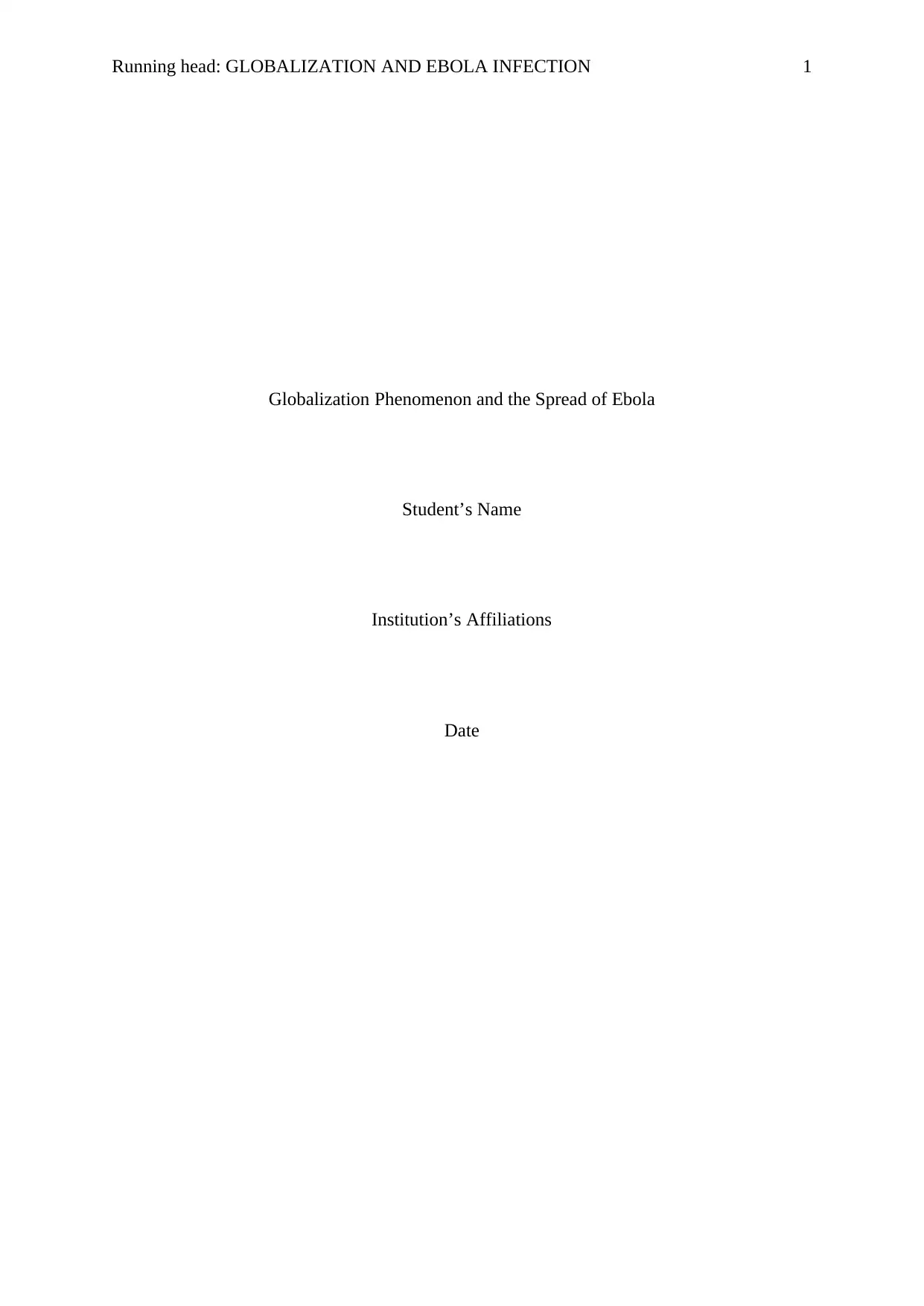
Running head: GLOBALIZATION AND EBOLA INFECTION 1
Globalization Phenomenon and the Spread of Ebola
Student’s Name
Institution’s Affiliations
Date
Globalization Phenomenon and the Spread of Ebola
Student’s Name
Institution’s Affiliations
Date
Paraphrase This Document
Need a fresh take? Get an instant paraphrase of this document with our AI Paraphraser
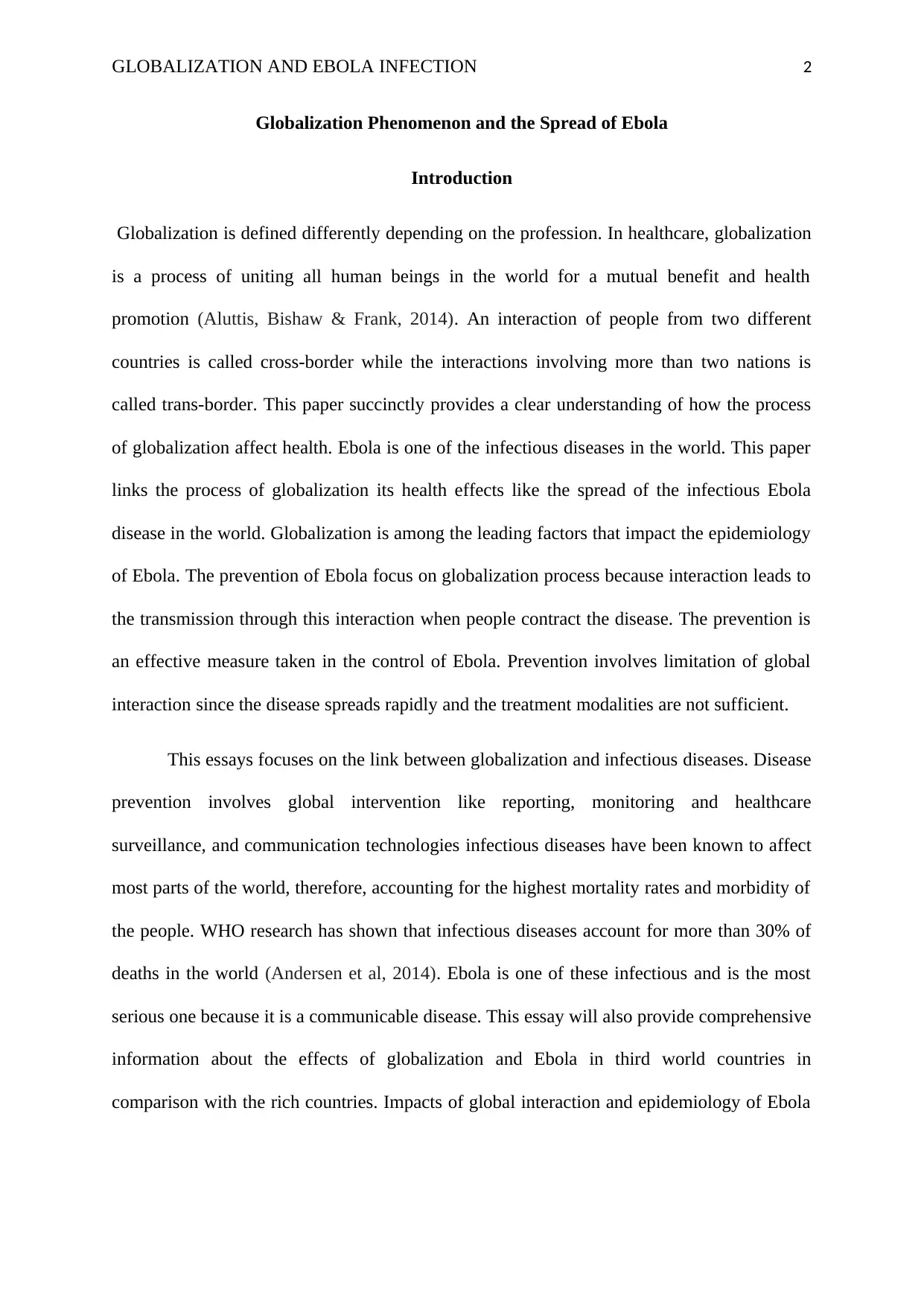
GLOBALIZATION AND EBOLA INFECTION 2
Globalization Phenomenon and the Spread of Ebola
Introduction
Globalization is defined differently depending on the profession. In healthcare, globalization
is a process of uniting all human beings in the world for a mutual benefit and health
promotion (Aluttis, Bishaw & Frank, 2014). An interaction of people from two different
countries is called cross-border while the interactions involving more than two nations is
called trans-border. This paper succinctly provides a clear understanding of how the process
of globalization affect health. Ebola is one of the infectious diseases in the world. This paper
links the process of globalization its health effects like the spread of the infectious Ebola
disease in the world. Globalization is among the leading factors that impact the epidemiology
of Ebola. The prevention of Ebola focus on globalization process because interaction leads to
the transmission through this interaction when people contract the disease. The prevention is
an effective measure taken in the control of Ebola. Prevention involves limitation of global
interaction since the disease spreads rapidly and the treatment modalities are not sufficient.
This essays focuses on the link between globalization and infectious diseases. Disease
prevention involves global intervention like reporting, monitoring and healthcare
surveillance, and communication technologies infectious diseases have been known to affect
most parts of the world, therefore, accounting for the highest mortality rates and morbidity of
the people. WHO research has shown that infectious diseases account for more than 30% of
deaths in the world (Andersen et al, 2014). Ebola is one of these infectious and is the most
serious one because it is a communicable disease. This essay will also provide comprehensive
information about the effects of globalization and Ebola in third world countries in
comparison with the rich countries. Impacts of global interaction and epidemiology of Ebola
Globalization Phenomenon and the Spread of Ebola
Introduction
Globalization is defined differently depending on the profession. In healthcare, globalization
is a process of uniting all human beings in the world for a mutual benefit and health
promotion (Aluttis, Bishaw & Frank, 2014). An interaction of people from two different
countries is called cross-border while the interactions involving more than two nations is
called trans-border. This paper succinctly provides a clear understanding of how the process
of globalization affect health. Ebola is one of the infectious diseases in the world. This paper
links the process of globalization its health effects like the spread of the infectious Ebola
disease in the world. Globalization is among the leading factors that impact the epidemiology
of Ebola. The prevention of Ebola focus on globalization process because interaction leads to
the transmission through this interaction when people contract the disease. The prevention is
an effective measure taken in the control of Ebola. Prevention involves limitation of global
interaction since the disease spreads rapidly and the treatment modalities are not sufficient.
This essays focuses on the link between globalization and infectious diseases. Disease
prevention involves global intervention like reporting, monitoring and healthcare
surveillance, and communication technologies infectious diseases have been known to affect
most parts of the world, therefore, accounting for the highest mortality rates and morbidity of
the people. WHO research has shown that infectious diseases account for more than 30% of
deaths in the world (Andersen et al, 2014). Ebola is one of these infectious and is the most
serious one because it is a communicable disease. This essay will also provide comprehensive
information about the effects of globalization and Ebola in third world countries in
comparison with the rich countries. Impacts of global interaction and epidemiology of Ebola
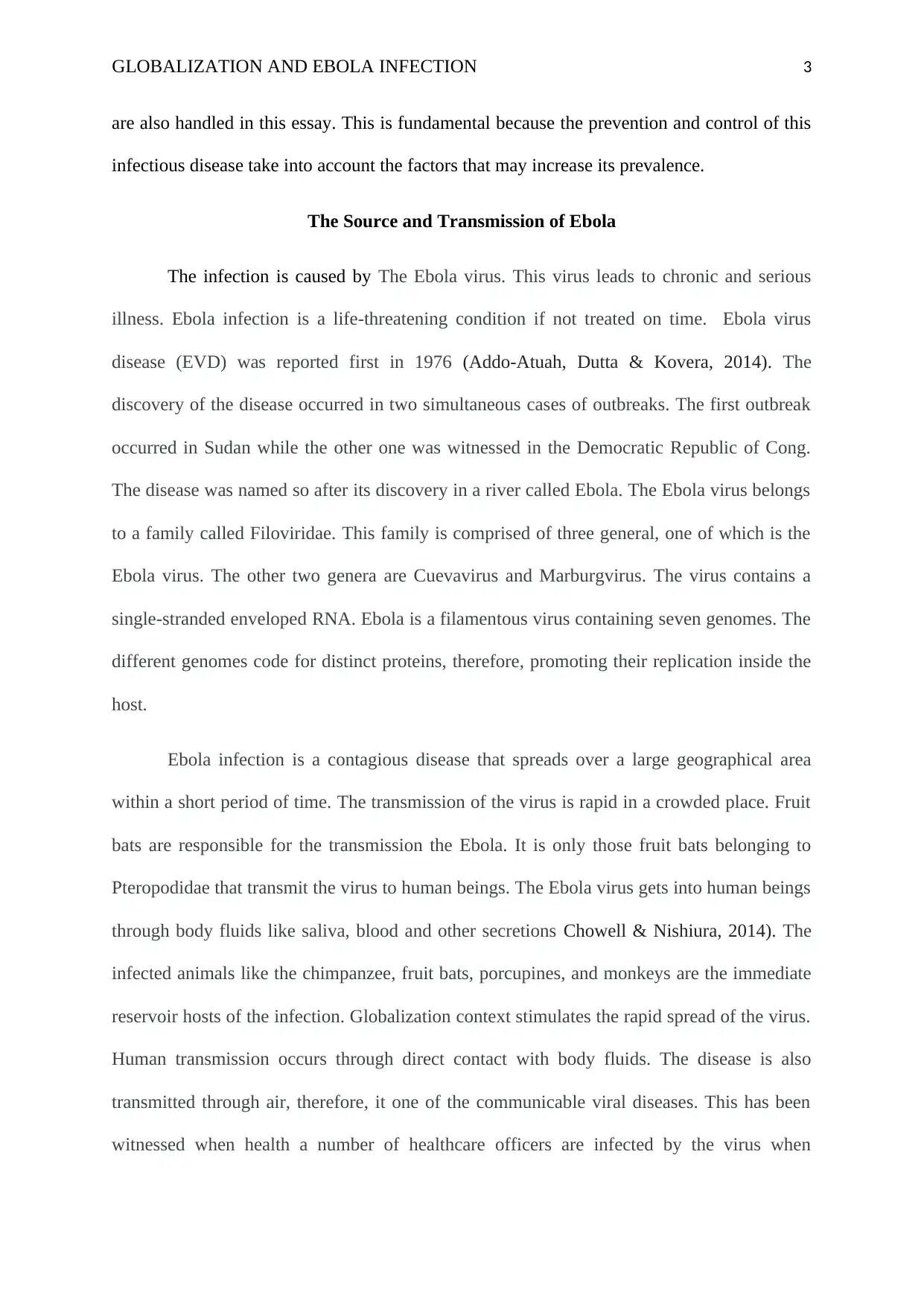
GLOBALIZATION AND EBOLA INFECTION 3
are also handled in this essay. This is fundamental because the prevention and control of this
infectious disease take into account the factors that may increase its prevalence.
The Source and Transmission of Ebola
The infection is caused by The Ebola virus. This virus leads to chronic and serious
illness. Ebola infection is a life-threatening condition if not treated on time. Ebola virus
disease (EVD) was reported first in 1976 (Addo-Atuah, Dutta & Kovera, 2014). The
discovery of the disease occurred in two simultaneous cases of outbreaks. The first outbreak
occurred in Sudan while the other one was witnessed in the Democratic Republic of Cong.
The disease was named so after its discovery in a river called Ebola. The Ebola virus belongs
to a family called Filoviridae. This family is comprised of three general, one of which is the
Ebola virus. The other two genera are Cuevavirus and Marburgvirus. The virus contains a
single-stranded enveloped RNA. Ebola is a filamentous virus containing seven genomes. The
different genomes code for distinct proteins, therefore, promoting their replication inside the
host.
Ebola infection is a contagious disease that spreads over a large geographical area
within a short period of time. The transmission of the virus is rapid in a crowded place. Fruit
bats are responsible for the transmission the Ebola. It is only those fruit bats belonging to
Pteropodidae that transmit the virus to human beings. The Ebola virus gets into human beings
through body fluids like saliva, blood and other secretions Chowell & Nishiura, 2014). The
infected animals like the chimpanzee, fruit bats, porcupines, and monkeys are the immediate
reservoir hosts of the infection. Globalization context stimulates the rapid spread of the virus.
Human transmission occurs through direct contact with body fluids. The disease is also
transmitted through air, therefore, it one of the communicable viral diseases. This has been
witnessed when health a number of healthcare officers are infected by the virus when
are also handled in this essay. This is fundamental because the prevention and control of this
infectious disease take into account the factors that may increase its prevalence.
The Source and Transmission of Ebola
The infection is caused by The Ebola virus. This virus leads to chronic and serious
illness. Ebola infection is a life-threatening condition if not treated on time. Ebola virus
disease (EVD) was reported first in 1976 (Addo-Atuah, Dutta & Kovera, 2014). The
discovery of the disease occurred in two simultaneous cases of outbreaks. The first outbreak
occurred in Sudan while the other one was witnessed in the Democratic Republic of Cong.
The disease was named so after its discovery in a river called Ebola. The Ebola virus belongs
to a family called Filoviridae. This family is comprised of three general, one of which is the
Ebola virus. The other two genera are Cuevavirus and Marburgvirus. The virus contains a
single-stranded enveloped RNA. Ebola is a filamentous virus containing seven genomes. The
different genomes code for distinct proteins, therefore, promoting their replication inside the
host.
Ebola infection is a contagious disease that spreads over a large geographical area
within a short period of time. The transmission of the virus is rapid in a crowded place. Fruit
bats are responsible for the transmission the Ebola. It is only those fruit bats belonging to
Pteropodidae that transmit the virus to human beings. The Ebola virus gets into human beings
through body fluids like saliva, blood and other secretions Chowell & Nishiura, 2014). The
infected animals like the chimpanzee, fruit bats, porcupines, and monkeys are the immediate
reservoir hosts of the infection. Globalization context stimulates the rapid spread of the virus.
Human transmission occurs through direct contact with body fluids. The disease is also
transmitted through air, therefore, it one of the communicable viral diseases. This has been
witnessed when health a number of healthcare officers are infected by the virus when
⊘ This is a preview!⊘
Do you want full access?
Subscribe today to unlock all pages.

Trusted by 1+ million students worldwide
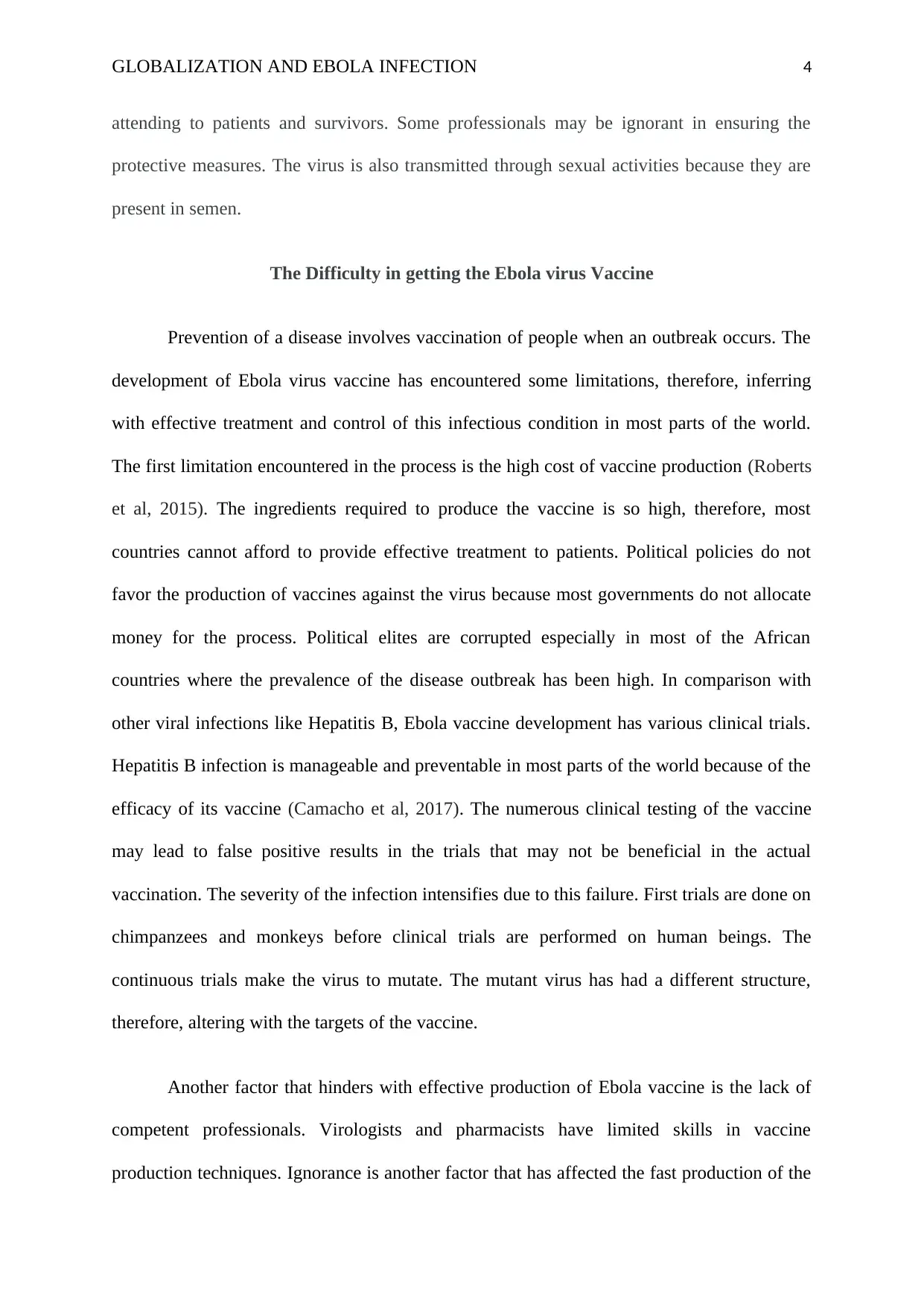
GLOBALIZATION AND EBOLA INFECTION 4
attending to patients and survivors. Some professionals may be ignorant in ensuring the
protective measures. The virus is also transmitted through sexual activities because they are
present in semen.
The Difficulty in getting the Ebola virus Vaccine
Prevention of a disease involves vaccination of people when an outbreak occurs. The
development of Ebola virus vaccine has encountered some limitations, therefore, inferring
with effective treatment and control of this infectious condition in most parts of the world.
The first limitation encountered in the process is the high cost of vaccine production (Roberts
et al, 2015). The ingredients required to produce the vaccine is so high, therefore, most
countries cannot afford to provide effective treatment to patients. Political policies do not
favor the production of vaccines against the virus because most governments do not allocate
money for the process. Political elites are corrupted especially in most of the African
countries where the prevalence of the disease outbreak has been high. In comparison with
other viral infections like Hepatitis B, Ebola vaccine development has various clinical trials.
Hepatitis B infection is manageable and preventable in most parts of the world because of the
efficacy of its vaccine (Camacho et al, 2017). The numerous clinical testing of the vaccine
may lead to false positive results in the trials that may not be beneficial in the actual
vaccination. The severity of the infection intensifies due to this failure. First trials are done on
chimpanzees and monkeys before clinical trials are performed on human beings. The
continuous trials make the virus to mutate. The mutant virus has had a different structure,
therefore, altering with the targets of the vaccine.
Another factor that hinders with effective production of Ebola vaccine is the lack of
competent professionals. Virologists and pharmacists have limited skills in vaccine
production techniques. Ignorance is another factor that has affected the fast production of the
attending to patients and survivors. Some professionals may be ignorant in ensuring the
protective measures. The virus is also transmitted through sexual activities because they are
present in semen.
The Difficulty in getting the Ebola virus Vaccine
Prevention of a disease involves vaccination of people when an outbreak occurs. The
development of Ebola virus vaccine has encountered some limitations, therefore, inferring
with effective treatment and control of this infectious condition in most parts of the world.
The first limitation encountered in the process is the high cost of vaccine production (Roberts
et al, 2015). The ingredients required to produce the vaccine is so high, therefore, most
countries cannot afford to provide effective treatment to patients. Political policies do not
favor the production of vaccines against the virus because most governments do not allocate
money for the process. Political elites are corrupted especially in most of the African
countries where the prevalence of the disease outbreak has been high. In comparison with
other viral infections like Hepatitis B, Ebola vaccine development has various clinical trials.
Hepatitis B infection is manageable and preventable in most parts of the world because of the
efficacy of its vaccine (Camacho et al, 2017). The numerous clinical testing of the vaccine
may lead to false positive results in the trials that may not be beneficial in the actual
vaccination. The severity of the infection intensifies due to this failure. First trials are done on
chimpanzees and monkeys before clinical trials are performed on human beings. The
continuous trials make the virus to mutate. The mutant virus has had a different structure,
therefore, altering with the targets of the vaccine.
Another factor that hinders with effective production of Ebola vaccine is the lack of
competent professionals. Virologists and pharmacists have limited skills in vaccine
production techniques. Ignorance is another factor that has affected the fast production of the
Paraphrase This Document
Need a fresh take? Get an instant paraphrase of this document with our AI Paraphraser
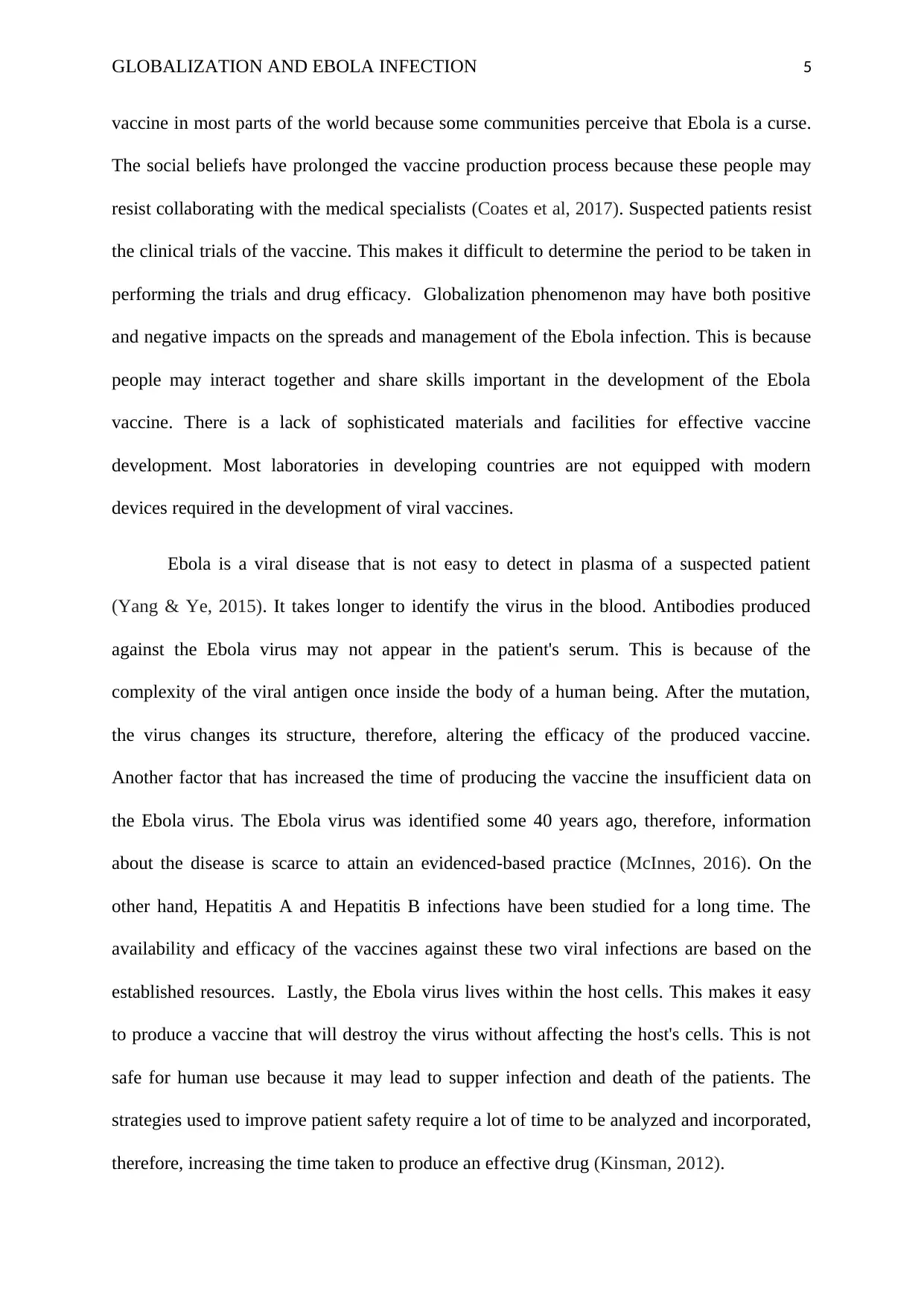
GLOBALIZATION AND EBOLA INFECTION 5
vaccine in most parts of the world because some communities perceive that Ebola is a curse.
The social beliefs have prolonged the vaccine production process because these people may
resist collaborating with the medical specialists (Coates et al, 2017). Suspected patients resist
the clinical trials of the vaccine. This makes it difficult to determine the period to be taken in
performing the trials and drug efficacy. Globalization phenomenon may have both positive
and negative impacts on the spreads and management of the Ebola infection. This is because
people may interact together and share skills important in the development of the Ebola
vaccine. There is a lack of sophisticated materials and facilities for effective vaccine
development. Most laboratories in developing countries are not equipped with modern
devices required in the development of viral vaccines.
Ebola is a viral disease that is not easy to detect in plasma of a suspected patient
(Yang & Ye, 2015). It takes longer to identify the virus in the blood. Antibodies produced
against the Ebola virus may not appear in the patient's serum. This is because of the
complexity of the viral antigen once inside the body of a human being. After the mutation,
the virus changes its structure, therefore, altering the efficacy of the produced vaccine.
Another factor that has increased the time of producing the vaccine the insufficient data on
the Ebola virus. The Ebola virus was identified some 40 years ago, therefore, information
about the disease is scarce to attain an evidenced-based practice (McInnes, 2016). On the
other hand, Hepatitis A and Hepatitis B infections have been studied for a long time. The
availability and efficacy of the vaccines against these two viral infections are based on the
established resources. Lastly, the Ebola virus lives within the host cells. This makes it easy
to produce a vaccine that will destroy the virus without affecting the host's cells. This is not
safe for human use because it may lead to supper infection and death of the patients. The
strategies used to improve patient safety require a lot of time to be analyzed and incorporated,
therefore, increasing the time taken to produce an effective drug (Kinsman, 2012).
vaccine in most parts of the world because some communities perceive that Ebola is a curse.
The social beliefs have prolonged the vaccine production process because these people may
resist collaborating with the medical specialists (Coates et al, 2017). Suspected patients resist
the clinical trials of the vaccine. This makes it difficult to determine the period to be taken in
performing the trials and drug efficacy. Globalization phenomenon may have both positive
and negative impacts on the spreads and management of the Ebola infection. This is because
people may interact together and share skills important in the development of the Ebola
vaccine. There is a lack of sophisticated materials and facilities for effective vaccine
development. Most laboratories in developing countries are not equipped with modern
devices required in the development of viral vaccines.
Ebola is a viral disease that is not easy to detect in plasma of a suspected patient
(Yang & Ye, 2015). It takes longer to identify the virus in the blood. Antibodies produced
against the Ebola virus may not appear in the patient's serum. This is because of the
complexity of the viral antigen once inside the body of a human being. After the mutation,
the virus changes its structure, therefore, altering the efficacy of the produced vaccine.
Another factor that has increased the time of producing the vaccine the insufficient data on
the Ebola virus. The Ebola virus was identified some 40 years ago, therefore, information
about the disease is scarce to attain an evidenced-based practice (McInnes, 2016). On the
other hand, Hepatitis A and Hepatitis B infections have been studied for a long time. The
availability and efficacy of the vaccines against these two viral infections are based on the
established resources. Lastly, the Ebola virus lives within the host cells. This makes it easy
to produce a vaccine that will destroy the virus without affecting the host's cells. This is not
safe for human use because it may lead to supper infection and death of the patients. The
strategies used to improve patient safety require a lot of time to be analyzed and incorporated,
therefore, increasing the time taken to produce an effective drug (Kinsman, 2012).
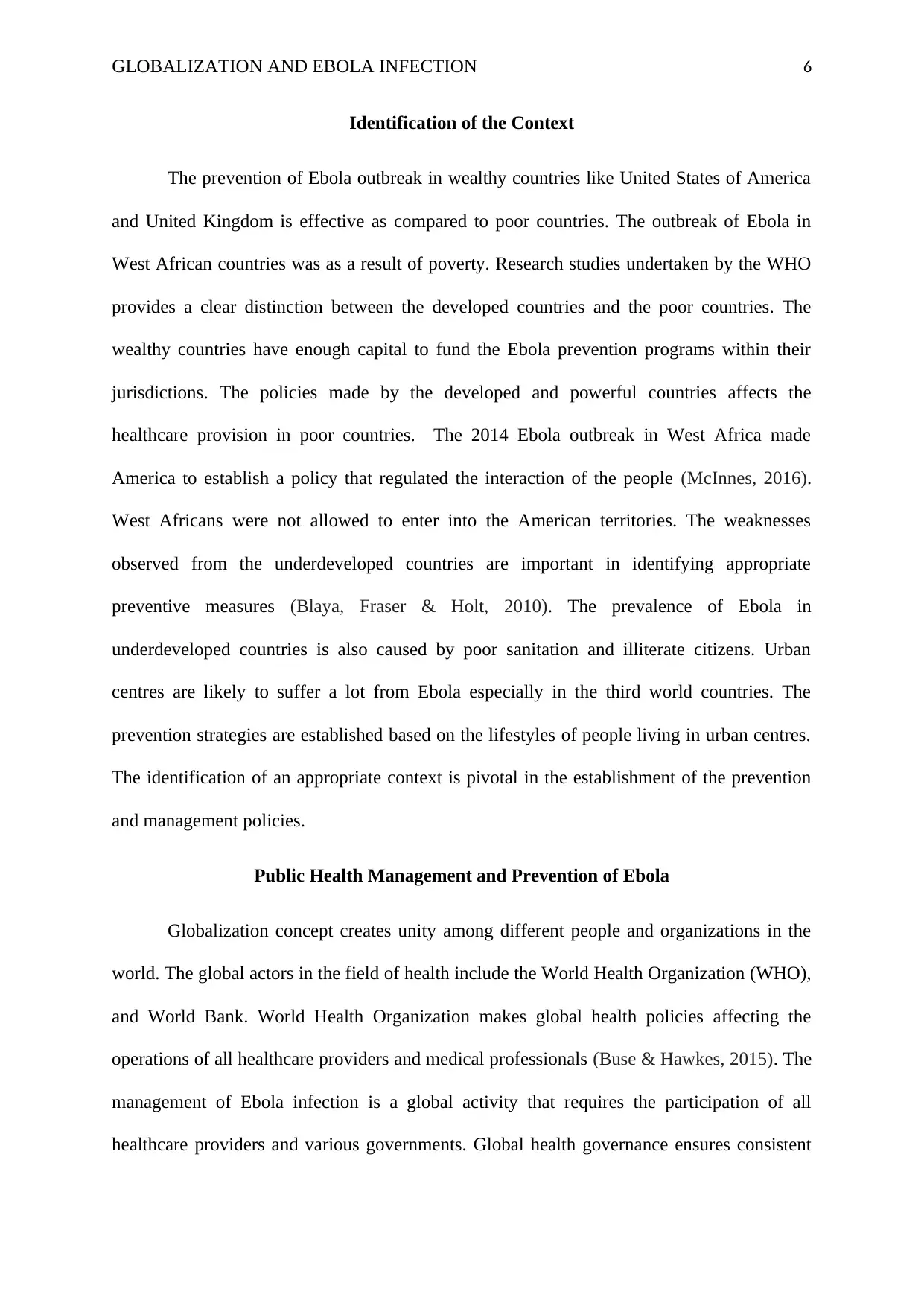
GLOBALIZATION AND EBOLA INFECTION 6
Identification of the Context
The prevention of Ebola outbreak in wealthy countries like United States of America
and United Kingdom is effective as compared to poor countries. The outbreak of Ebola in
West African countries was as a result of poverty. Research studies undertaken by the WHO
provides a clear distinction between the developed countries and the poor countries. The
wealthy countries have enough capital to fund the Ebola prevention programs within their
jurisdictions. The policies made by the developed and powerful countries affects the
healthcare provision in poor countries. The 2014 Ebola outbreak in West Africa made
America to establish a policy that regulated the interaction of the people (McInnes, 2016).
West Africans were not allowed to enter into the American territories. The weaknesses
observed from the underdeveloped countries are important in identifying appropriate
preventive measures (Blaya, Fraser & Holt, 2010). The prevalence of Ebola in
underdeveloped countries is also caused by poor sanitation and illiterate citizens. Urban
centres are likely to suffer a lot from Ebola especially in the third world countries. The
prevention strategies are established based on the lifestyles of people living in urban centres.
The identification of an appropriate context is pivotal in the establishment of the prevention
and management policies.
Public Health Management and Prevention of Ebola
Globalization concept creates unity among different people and organizations in the
world. The global actors in the field of health include the World Health Organization (WHO),
and World Bank. World Health Organization makes global health policies affecting the
operations of all healthcare providers and medical professionals (Buse & Hawkes, 2015). The
management of Ebola infection is a global activity that requires the participation of all
healthcare providers and various governments. Global health governance ensures consistent
Identification of the Context
The prevention of Ebola outbreak in wealthy countries like United States of America
and United Kingdom is effective as compared to poor countries. The outbreak of Ebola in
West African countries was as a result of poverty. Research studies undertaken by the WHO
provides a clear distinction between the developed countries and the poor countries. The
wealthy countries have enough capital to fund the Ebola prevention programs within their
jurisdictions. The policies made by the developed and powerful countries affects the
healthcare provision in poor countries. The 2014 Ebola outbreak in West Africa made
America to establish a policy that regulated the interaction of the people (McInnes, 2016).
West Africans were not allowed to enter into the American territories. The weaknesses
observed from the underdeveloped countries are important in identifying appropriate
preventive measures (Blaya, Fraser & Holt, 2010). The prevalence of Ebola in
underdeveloped countries is also caused by poor sanitation and illiterate citizens. Urban
centres are likely to suffer a lot from Ebola especially in the third world countries. The
prevention strategies are established based on the lifestyles of people living in urban centres.
The identification of an appropriate context is pivotal in the establishment of the prevention
and management policies.
Public Health Management and Prevention of Ebola
Globalization concept creates unity among different people and organizations in the
world. The global actors in the field of health include the World Health Organization (WHO),
and World Bank. World Health Organization makes global health policies affecting the
operations of all healthcare providers and medical professionals (Buse & Hawkes, 2015). The
management of Ebola infection is a global activity that requires the participation of all
healthcare providers and various governments. Global health governance ensures consistent
⊘ This is a preview!⊘
Do you want full access?
Subscribe today to unlock all pages.

Trusted by 1+ million students worldwide
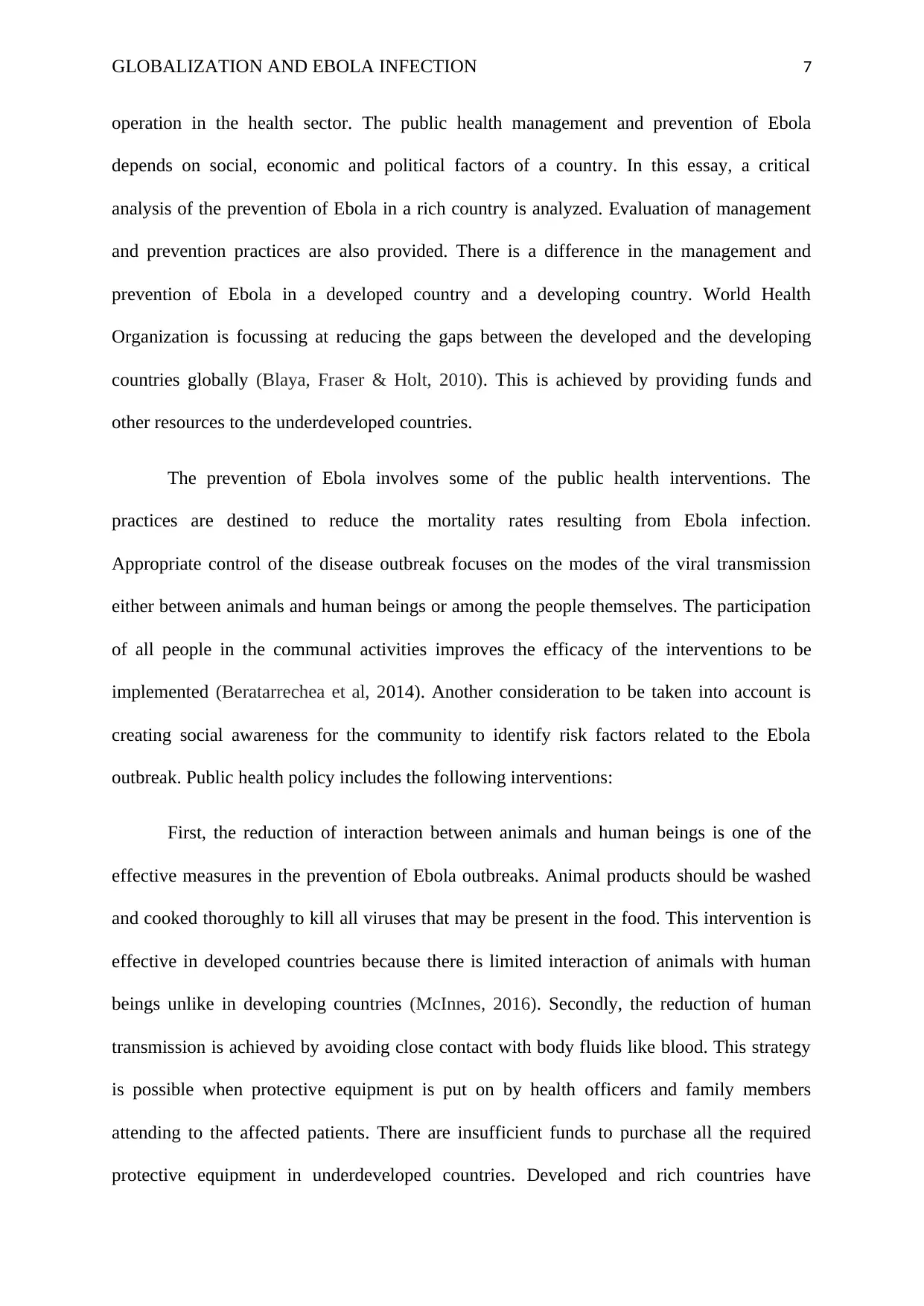
GLOBALIZATION AND EBOLA INFECTION 7
operation in the health sector. The public health management and prevention of Ebola
depends on social, economic and political factors of a country. In this essay, a critical
analysis of the prevention of Ebola in a rich country is analyzed. Evaluation of management
and prevention practices are also provided. There is a difference in the management and
prevention of Ebola in a developed country and a developing country. World Health
Organization is focussing at reducing the gaps between the developed and the developing
countries globally (Blaya, Fraser & Holt, 2010). This is achieved by providing funds and
other resources to the underdeveloped countries.
The prevention of Ebola involves some of the public health interventions. The
practices are destined to reduce the mortality rates resulting from Ebola infection.
Appropriate control of the disease outbreak focuses on the modes of the viral transmission
either between animals and human beings or among the people themselves. The participation
of all people in the communal activities improves the efficacy of the interventions to be
implemented (Beratarrechea et al, 2014). Another consideration to be taken into account is
creating social awareness for the community to identify risk factors related to the Ebola
outbreak. Public health policy includes the following interventions:
First, the reduction of interaction between animals and human beings is one of the
effective measures in the prevention of Ebola outbreaks. Animal products should be washed
and cooked thoroughly to kill all viruses that may be present in the food. This intervention is
effective in developed countries because there is limited interaction of animals with human
beings unlike in developing countries (McInnes, 2016). Secondly, the reduction of human
transmission is achieved by avoiding close contact with body fluids like blood. This strategy
is possible when protective equipment is put on by health officers and family members
attending to the affected patients. There are insufficient funds to purchase all the required
protective equipment in underdeveloped countries. Developed and rich countries have
operation in the health sector. The public health management and prevention of Ebola
depends on social, economic and political factors of a country. In this essay, a critical
analysis of the prevention of Ebola in a rich country is analyzed. Evaluation of management
and prevention practices are also provided. There is a difference in the management and
prevention of Ebola in a developed country and a developing country. World Health
Organization is focussing at reducing the gaps between the developed and the developing
countries globally (Blaya, Fraser & Holt, 2010). This is achieved by providing funds and
other resources to the underdeveloped countries.
The prevention of Ebola involves some of the public health interventions. The
practices are destined to reduce the mortality rates resulting from Ebola infection.
Appropriate control of the disease outbreak focuses on the modes of the viral transmission
either between animals and human beings or among the people themselves. The participation
of all people in the communal activities improves the efficacy of the interventions to be
implemented (Beratarrechea et al, 2014). Another consideration to be taken into account is
creating social awareness for the community to identify risk factors related to the Ebola
outbreak. Public health policy includes the following interventions:
First, the reduction of interaction between animals and human beings is one of the
effective measures in the prevention of Ebola outbreaks. Animal products should be washed
and cooked thoroughly to kill all viruses that may be present in the food. This intervention is
effective in developed countries because there is limited interaction of animals with human
beings unlike in developing countries (McInnes, 2016). Secondly, the reduction of human
transmission is achieved by avoiding close contact with body fluids like blood. This strategy
is possible when protective equipment is put on by health officers and family members
attending to the affected patients. There are insufficient funds to purchase all the required
protective equipment in underdeveloped countries. Developed and rich countries have
Paraphrase This Document
Need a fresh take? Get an instant paraphrase of this document with our AI Paraphraser
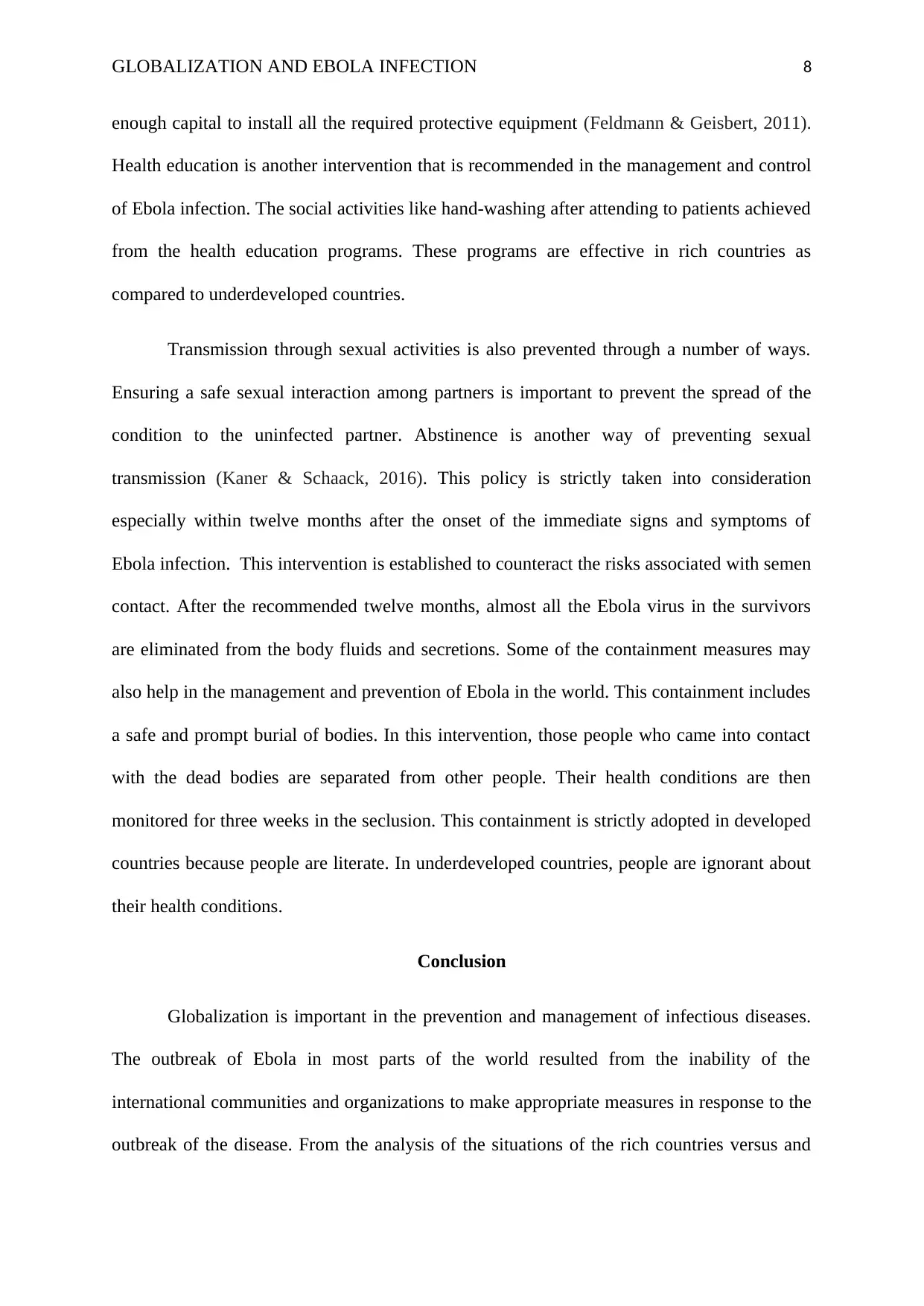
GLOBALIZATION AND EBOLA INFECTION 8
enough capital to install all the required protective equipment (Feldmann & Geisbert, 2011).
Health education is another intervention that is recommended in the management and control
of Ebola infection. The social activities like hand-washing after attending to patients achieved
from the health education programs. These programs are effective in rich countries as
compared to underdeveloped countries.
Transmission through sexual activities is also prevented through a number of ways.
Ensuring a safe sexual interaction among partners is important to prevent the spread of the
condition to the uninfected partner. Abstinence is another way of preventing sexual
transmission (Kaner & Schaack, 2016). This policy is strictly taken into consideration
especially within twelve months after the onset of the immediate signs and symptoms of
Ebola infection. This intervention is established to counteract the risks associated with semen
contact. After the recommended twelve months, almost all the Ebola virus in the survivors
are eliminated from the body fluids and secretions. Some of the containment measures may
also help in the management and prevention of Ebola in the world. This containment includes
a safe and prompt burial of bodies. In this intervention, those people who came into contact
with the dead bodies are separated from other people. Their health conditions are then
monitored for three weeks in the seclusion. This containment is strictly adopted in developed
countries because people are literate. In underdeveloped countries, people are ignorant about
their health conditions.
Conclusion
Globalization is important in the prevention and management of infectious diseases.
The outbreak of Ebola in most parts of the world resulted from the inability of the
international communities and organizations to make appropriate measures in response to the
outbreak of the disease. From the analysis of the situations of the rich countries versus and
enough capital to install all the required protective equipment (Feldmann & Geisbert, 2011).
Health education is another intervention that is recommended in the management and control
of Ebola infection. The social activities like hand-washing after attending to patients achieved
from the health education programs. These programs are effective in rich countries as
compared to underdeveloped countries.
Transmission through sexual activities is also prevented through a number of ways.
Ensuring a safe sexual interaction among partners is important to prevent the spread of the
condition to the uninfected partner. Abstinence is another way of preventing sexual
transmission (Kaner & Schaack, 2016). This policy is strictly taken into consideration
especially within twelve months after the onset of the immediate signs and symptoms of
Ebola infection. This intervention is established to counteract the risks associated with semen
contact. After the recommended twelve months, almost all the Ebola virus in the survivors
are eliminated from the body fluids and secretions. Some of the containment measures may
also help in the management and prevention of Ebola in the world. This containment includes
a safe and prompt burial of bodies. In this intervention, those people who came into contact
with the dead bodies are separated from other people. Their health conditions are then
monitored for three weeks in the seclusion. This containment is strictly adopted in developed
countries because people are literate. In underdeveloped countries, people are ignorant about
their health conditions.
Conclusion
Globalization is important in the prevention and management of infectious diseases.
The outbreak of Ebola in most parts of the world resulted from the inability of the
international communities and organizations to make appropriate measures in response to the
outbreak of the disease. From the analysis of the situations of the rich countries versus and
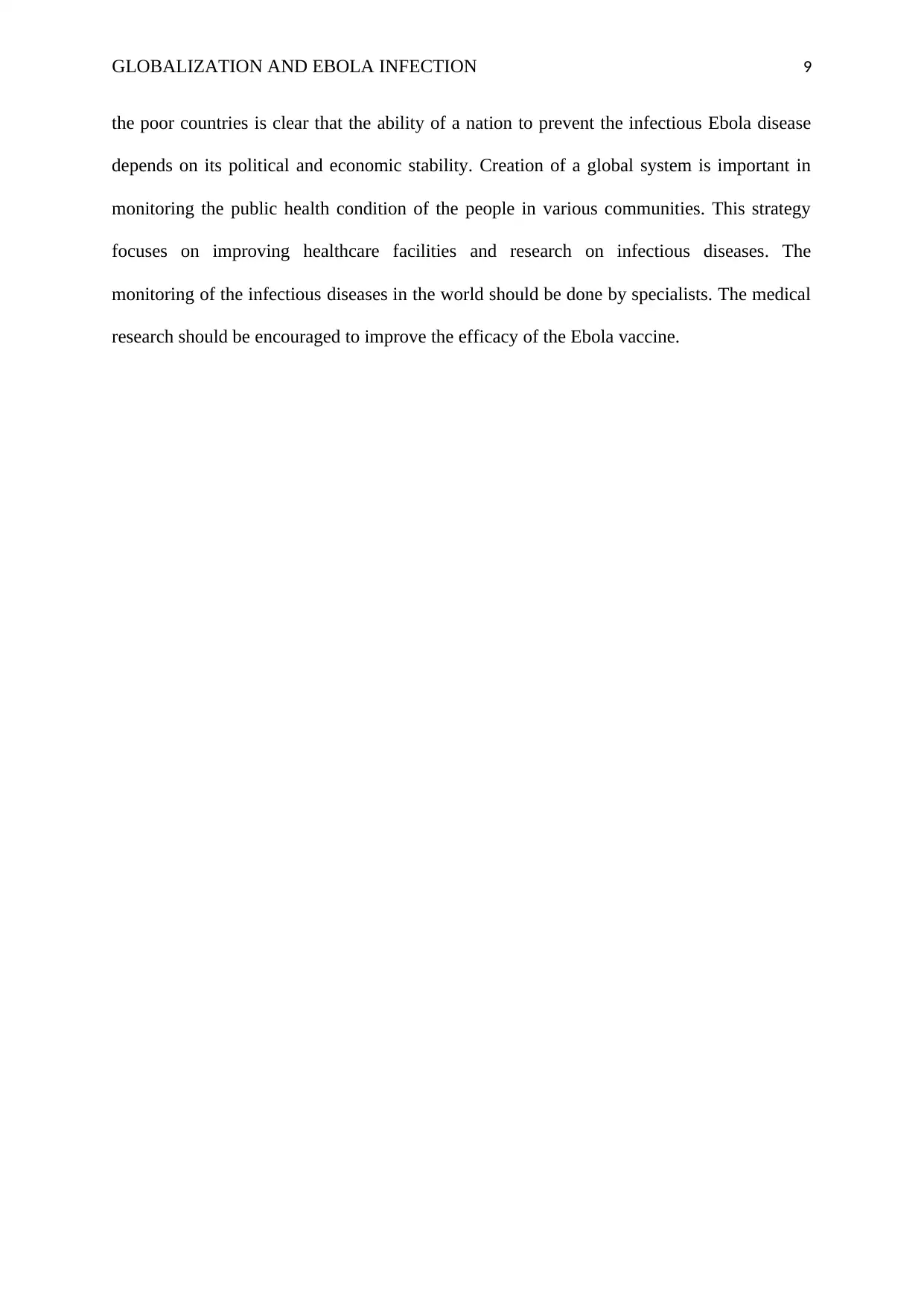
GLOBALIZATION AND EBOLA INFECTION 9
the poor countries is clear that the ability of a nation to prevent the infectious Ebola disease
depends on its political and economic stability. Creation of a global system is important in
monitoring the public health condition of the people in various communities. This strategy
focuses on improving healthcare facilities and research on infectious diseases. The
monitoring of the infectious diseases in the world should be done by specialists. The medical
research should be encouraged to improve the efficacy of the Ebola vaccine.
the poor countries is clear that the ability of a nation to prevent the infectious Ebola disease
depends on its political and economic stability. Creation of a global system is important in
monitoring the public health condition of the people in various communities. This strategy
focuses on improving healthcare facilities and research on infectious diseases. The
monitoring of the infectious diseases in the world should be done by specialists. The medical
research should be encouraged to improve the efficacy of the Ebola vaccine.
⊘ This is a preview!⊘
Do you want full access?
Subscribe today to unlock all pages.

Trusted by 1+ million students worldwide
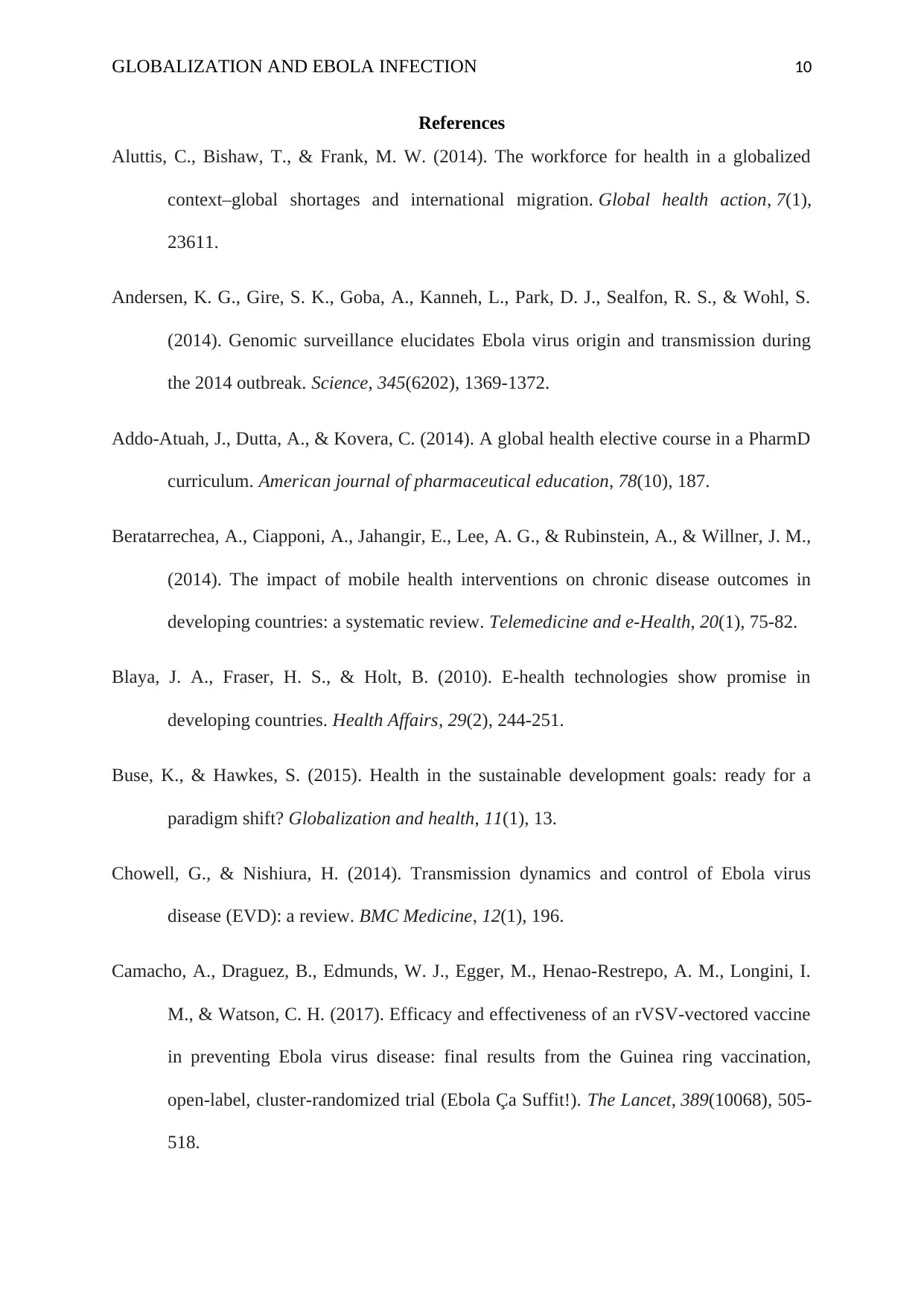
GLOBALIZATION AND EBOLA INFECTION 10
References
Aluttis, C., Bishaw, T., & Frank, M. W. (2014). The workforce for health in a globalized
context–global shortages and international migration. Global health action, 7(1),
23611.
Andersen, K. G., Gire, S. K., Goba, A., Kanneh, L., Park, D. J., Sealfon, R. S., & Wohl, S.
(2014). Genomic surveillance elucidates Ebola virus origin and transmission during
the 2014 outbreak. Science, 345(6202), 1369-1372.
Addo-Atuah, J., Dutta, A., & Kovera, C. (2014). A global health elective course in a PharmD
curriculum. American journal of pharmaceutical education, 78(10), 187.
Beratarrechea, A., Ciapponi, A., Jahangir, E., Lee, A. G., & Rubinstein, A., & Willner, J. M.,
(2014). The impact of mobile health interventions on chronic disease outcomes in
developing countries: a systematic review. Telemedicine and e-Health, 20(1), 75-82.
Blaya, J. A., Fraser, H. S., & Holt, B. (2010). E-health technologies show promise in
developing countries. Health Affairs, 29(2), 244-251.
Buse, K., & Hawkes, S. (2015). Health in the sustainable development goals: ready for a
paradigm shift? Globalization and health, 11(1), 13.
Chowell, G., & Nishiura, H. (2014). Transmission dynamics and control of Ebola virus
disease (EVD): a review. BMC Medicine, 12(1), 196.
Camacho, A., Draguez, B., Edmunds, W. J., Egger, M., Henao-Restrepo, A. M., Longini, I.
M., & Watson, C. H. (2017). Efficacy and effectiveness of an rVSV-vectored vaccine
in preventing Ebola virus disease: final results from the Guinea ring vaccination,
open-label, cluster-randomized trial (Ebola Ça Suffit!). The Lancet, 389(10068), 505-
518.
References
Aluttis, C., Bishaw, T., & Frank, M. W. (2014). The workforce for health in a globalized
context–global shortages and international migration. Global health action, 7(1),
23611.
Andersen, K. G., Gire, S. K., Goba, A., Kanneh, L., Park, D. J., Sealfon, R. S., & Wohl, S.
(2014). Genomic surveillance elucidates Ebola virus origin and transmission during
the 2014 outbreak. Science, 345(6202), 1369-1372.
Addo-Atuah, J., Dutta, A., & Kovera, C. (2014). A global health elective course in a PharmD
curriculum. American journal of pharmaceutical education, 78(10), 187.
Beratarrechea, A., Ciapponi, A., Jahangir, E., Lee, A. G., & Rubinstein, A., & Willner, J. M.,
(2014). The impact of mobile health interventions on chronic disease outcomes in
developing countries: a systematic review. Telemedicine and e-Health, 20(1), 75-82.
Blaya, J. A., Fraser, H. S., & Holt, B. (2010). E-health technologies show promise in
developing countries. Health Affairs, 29(2), 244-251.
Buse, K., & Hawkes, S. (2015). Health in the sustainable development goals: ready for a
paradigm shift? Globalization and health, 11(1), 13.
Chowell, G., & Nishiura, H. (2014). Transmission dynamics and control of Ebola virus
disease (EVD): a review. BMC Medicine, 12(1), 196.
Camacho, A., Draguez, B., Edmunds, W. J., Egger, M., Henao-Restrepo, A. M., Longini, I.
M., & Watson, C. H. (2017). Efficacy and effectiveness of an rVSV-vectored vaccine
in preventing Ebola virus disease: final results from the Guinea ring vaccination,
open-label, cluster-randomized trial (Ebola Ça Suffit!). The Lancet, 389(10068), 505-
518.
Paraphrase This Document
Need a fresh take? Get an instant paraphrase of this document with our AI Paraphraser
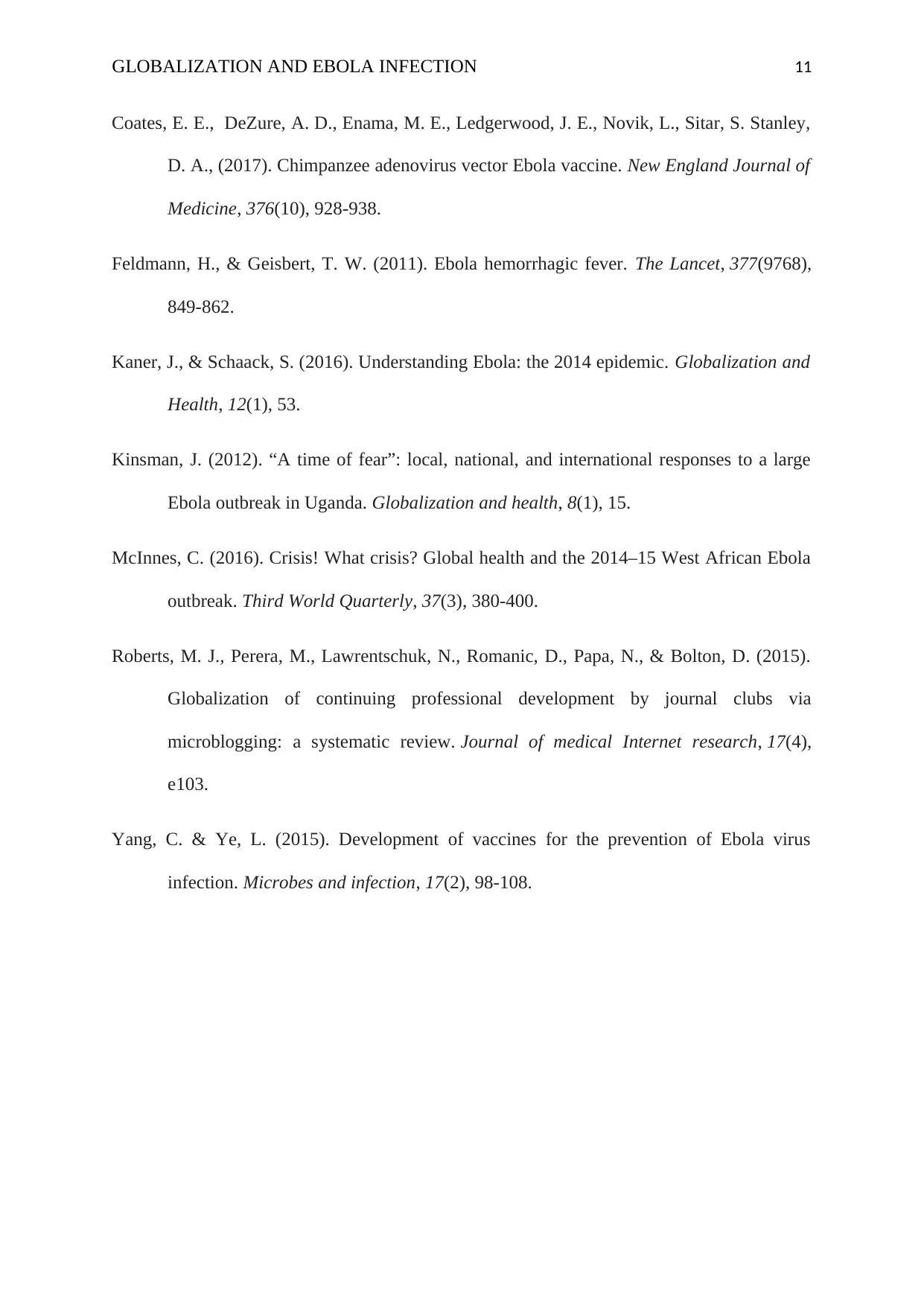
GLOBALIZATION AND EBOLA INFECTION 11
Coates, E. E., DeZure, A. D., Enama, M. E., Ledgerwood, J. E., Novik, L., Sitar, S. Stanley,
D. A., (2017). Chimpanzee adenovirus vector Ebola vaccine. New England Journal of
Medicine, 376(10), 928-938.
Feldmann, H., & Geisbert, T. W. (2011). Ebola hemorrhagic fever. The Lancet, 377(9768),
849-862.
Kaner, J., & Schaack, S. (2016). Understanding Ebola: the 2014 epidemic. Globalization and
Health, 12(1), 53.
Kinsman, J. (2012). “A time of fear”: local, national, and international responses to a large
Ebola outbreak in Uganda. Globalization and health, 8(1), 15.
McInnes, C. (2016). Crisis! What crisis? Global health and the 2014–15 West African Ebola
outbreak. Third World Quarterly, 37(3), 380-400.
Roberts, M. J., Perera, M., Lawrentschuk, N., Romanic, D., Papa, N., & Bolton, D. (2015).
Globalization of continuing professional development by journal clubs via
microblogging: a systematic review. Journal of medical Internet research, 17(4),
e103.
Yang, C. & Ye, L. (2015). Development of vaccines for the prevention of Ebola virus
infection. Microbes and infection, 17(2), 98-108.
Coates, E. E., DeZure, A. D., Enama, M. E., Ledgerwood, J. E., Novik, L., Sitar, S. Stanley,
D. A., (2017). Chimpanzee adenovirus vector Ebola vaccine. New England Journal of
Medicine, 376(10), 928-938.
Feldmann, H., & Geisbert, T. W. (2011). Ebola hemorrhagic fever. The Lancet, 377(9768),
849-862.
Kaner, J., & Schaack, S. (2016). Understanding Ebola: the 2014 epidemic. Globalization and
Health, 12(1), 53.
Kinsman, J. (2012). “A time of fear”: local, national, and international responses to a large
Ebola outbreak in Uganda. Globalization and health, 8(1), 15.
McInnes, C. (2016). Crisis! What crisis? Global health and the 2014–15 West African Ebola
outbreak. Third World Quarterly, 37(3), 380-400.
Roberts, M. J., Perera, M., Lawrentschuk, N., Romanic, D., Papa, N., & Bolton, D. (2015).
Globalization of continuing professional development by journal clubs via
microblogging: a systematic review. Journal of medical Internet research, 17(4),
e103.
Yang, C. & Ye, L. (2015). Development of vaccines for the prevention of Ebola virus
infection. Microbes and infection, 17(2), 98-108.
1 out of 11
Related Documents
Your All-in-One AI-Powered Toolkit for Academic Success.
+13062052269
info@desklib.com
Available 24*7 on WhatsApp / Email
![[object Object]](/_next/static/media/star-bottom.7253800d.svg)
Unlock your academic potential
Copyright © 2020–2025 A2Z Services. All Rights Reserved. Developed and managed by ZUCOL.





